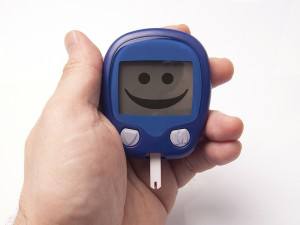Living with type 1 diabetes- a brave five year old learns to cope with needles
A type 1 diabetes diagnosis means many day to day changes and a lifetime of careful eating, doctor visits, insulin injections and monitoring blood sugar levels. These challenges are hard at any age, but in early childhood when kids want to eat what their friends eat and are still scared of needles, it’s particularly hard.
Tristan, a brave 5 year old boy, is one of 130,000 Australians living with Type 1 Diabetes. We spoke to his mum Suzie about how Tristan and his family have lived with type 1 diabetes for more than three years.
Developing diabetes-friendly family routines
Daily routines have changed since Tristan was diagnosed with Type 1 diabetes, just before his second birthday. “It means we always have to be prepared and make sure our daily routine includes time for things like healthy eating, exercising, blood sugar monitoring and insulin injections,” Suzie said.
“When Tristan’s blood sugar is low, he needs to eat sugar to correct it. Often we can do that by giving him jelly beans or something else sugary to eat. But sometimes he is too tired even to eat and we need to give him a glucose injection. Since he was diagnosed with type 1 diabetes, we carry a glucose injection everywhere we go.
“There are lots of supplies Tristan needs on a daily basis. We always carry around his diabetes management kit and his water bottle. Glucose injections, blood sugar test strips and containers to dispose of used needles and syringes are part of the furniture in our house these days.”
An average day for a type 1 diabetic
Tristan needs regular insulin to keep his blood glucose levels down, which means daily injections, and careful administration of the needles. “We have to make sure that the syringe doesn’t go too deep or we would be injecting in the muscle and this is quite painful.
“Sometimes the site where we inject becomes bruised or bleeds. We have to alternate sites so he doesn’t get infections or lumps under the skin. These can stop the insulin being absorbed and doing its job. We started off injecting his tummy and then had to move to his bottom as his tummy started getting quite lumpy. His bottom became quite swollen after a while and we were told to inject behind his arms.

“The insulin we inject won’t cure his condition, so far there is no cure for type 1 diabetes,” Suzie told us. “But the insulin he injects makes up for the insulin which his body doesn’t produce and keeps him alive and relatively healthy.”
“Tristan is still very young. He has learnt to inject but his dad and I still need to help him with the finger prick tests for blood glucose levels and other things. We record every test result so we can monitor the changes over time. We measure his food and make sure he eats the correct amount of different types of food according to his insulin level. The right amount changes all the time.”He also needs to check his blood glucose with a finger prick test several times each day. “He can’t eat without checking his blood glucose level first.”
Overcoming the great childhood fear of needles
One of the biggest and most difficult changes was the daily injections that were necessary to ensure Tristan got the insulin he needed to control his blood sugar. “He was just a kid and has always been afraid of needles. 9 times out of 10 he cried when he had to have them.”
But Tristan overcame his fear of needles quickly, and even learned to inject them himself, with the help of role models, older children living with type 1 diabetes that were self-injecting. “We attended the Diabetes Australia family camp, where parents and children living with type 1 diabetes get together and share their experience. Tristan was the second youngest child at the camp, so he got a lot out of it.”
“When Tristan saw the older kids injecting themselves, of course he wanted to do it as well when we got home. I drew up the insulin in the syringe and he injected himself and delivered the insulin, no tears or fuss. He even started to check his own blood glucose levels all by himself and started to take control of his diabetes. I was overjoyed and impressed that at just 5 years old he showed interest in his diabetes.”
Now Tristan uses an insulin pump which means less frequent injections and also makes eating a bit easier. “He has the freedom to eat as much as he wants. But we face other issues like air bubbles in the tube which connects the insulin pump to his body. When air bubbles are present, then the required insulin he needs to control his blood glucose is not getting through.”
Facing the facts and making family life normal
Even with daily monitoring and injections, Tristan will always be diabetic. “Type 1 diabetes is incurable. He will live with this condition for the rest of his life, going to hospital every three months to check his progress and testing and injecting every day to control his blood sugar levels.
“In the long term he will also have a high risk of complications like diabetic eye diseases, heart and kidney problems. But we try to make his life as normal as possible. We just take it one day at a time and know we have a long journey ahead of us.
“It’s a disease that affects the whole family and has meant enormous changes for us all,” Suzie told us. “But Tristan has the most to cope with. It’s his courage and persistence that inspires us all.”

There were many challenges for Tristan’s parents as they tried to adjust their lifestyles so they could provide Tristan the best diabetes care possible, and look after their three other children. “It places restrictions on our day to day lives. That’s a sacrifice we’re willing to make but we feel that our other children miss out on a lot of our attention as most of our time and energy is focused on caring for Tristan.”
But there’s hope that things will become a little easier as Tristan grows up. Now he’s at school, Suzie says “His teacher and the class aid have become experts in testing his levels and working his insulin pump in the short time that Tristan has attended. If this continues I can go to full time work when my youngest starts school next year as well.”
Support and awarenessFull time work will help a bit with the medical expenses. “Financially it has been a bit tight as Tristan’s medical supplies cost $300-$400 per month even with a health care card. To get the insulin pump we had to have private health insurance or pay $9,000.00 outright- the pump has to be replaced every 4 years.”
Coping with type 1 diabetes has not been easy for Tristan or his family, but Suzie said joining support organisations and helping raise awareness of the condition has helped. “The main organisation that we belong to is Diabetes Australia – Victoria. I organise get-togethers and events for two support groups, ‘The Courageous 1s’ and ‘Sugarbabes’. We try to get the families together at least every 3 months so that the parents don’t feel that they are alone on their journey. For the kids it’s so nice to see them smile and know that they are not the only ones that have to live with the daily challenges. These support groups are so important to the many families that attend.
“The other organisation that we are in constant contact with is JDRF (Juvenile Diabetes Research Foundation). They are working on research for the much needed cure, management and also prevention. With funds greatly needed for the 40+ trials that are currently being carried out, we fundraise and have as many events as we can during the year to raise every dollar we can to bring us that much closer to the cure.”
Advice to parents
“It truly has been a challenging journey for our family but it is well worth every minute of it just to see Tristan’s beautiful and cheeky smile each day or to hear him say, ‘Mummy, I love you a hundred’ each night without fail as he goes to bed.”
“We are just one of the many thousands of families living with Type 1 diabetes. Though the journey can be quite difficult at times, getting support and knowing that you and your child and family are not alone is so important. I’d encourage other parents to get involved in organisations like Diabetes Australia,” Suzie said.
Although going to a diabetes camp can be costly and there are not always spaces, Suzie said she, “would recommend it to all newly diagnosed families as the kids gain so much confidence and emotionally it is something that has a huge benefit for the kids as well as the parent. It is so important that the kids know that they are not alone on this journey.”
Suzie says it’s also important for parents to remember, “it’s not all doom and gloom. Tristan is otherwise a ‘normal’ and healthy five year old and looking at him you would not guess that he carries this huge burden on his tiny little shoulders.”
References
Dates
Tags
Created by:

 Login
Login














